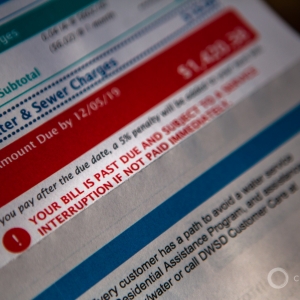Federal Water Tap, May 3: Senate Overwhelmingly Passes Water Infrastructure Bill
The Rundown
By a near-unanimous margin, the Senate approved a broad water infrastructure package. FERC commissioners discuss incorporating environmental justice into their evaluation of energy infrastructure. The EPA announces a new round of WIFIA funds and approves grant funding for water systems in two Alaska Native villages. President Biden nominates a government veteran to lead the Army Corps of Engineers. And lastly, the GAO recommends that the EPA updated its database with more accurate information on drinking water utility ownership.
“This legislation represents, I think, a fantastic first effort for our ongoing work together to address the major concerns of the American people when it comes to infrastructure and the environment, and in a thoughtful and fiscally responsible fashion.” — Sen. Shelley Moore Capito (R-WV) speaking on the Senate floor in support of a drinking water and wastewater infrastructure bill. The bill passed by an 89 to 2 margin.
By the Numbers
$6.5 billion: Credit available to finance water and wastewater infrastructure in fiscal year 2021 through two U.S. Environmental Protection Agency low-interest loan programs. There is $5.5 billion available through WIFIA, which provides loans for municipal projects, and $1 billion through SWIFIA, which targets state infrastructure authorities.
$9 million: Grant funding awarded by the EPA for drinking water improvements in two Alaska Native villages, Tuluksak and Stebbins. The funding is part of the Water Infrastructure Improvements for the Nation Act that Congress passed in 2016.
$20 million: Funding available under the American Rescue Plan to provide potable water on Indian reservations. The Bureau of Indian Affairs will distribute the money to regional offices, which will select projects based on need.
News Briefs
Water Infrastructure Bill
In a show of broad support, the Senate endorsed a water infrastructure bill that expands potential funding for drinking water and sewage systems.
By an 89 to 2 margin, the Senate passed the Drinking Water and Wastewater Infrastructure Act.
The act has reach. One headline item is that it increases authorized annual funding for the Drinking Water and Clean Water State Revolving Funds to $3.25 billion each by 2025. Actual funding levels will be determined in the budget process.
Other spending authorizations (but not appropriations): grants for improving sanitation in Alaska Native villages, grants for removing lead pipes, grants for connecting homes to public water, and grants to disadvantaged communities.
Et cetera items: a study of boil-water advisories in the U.S., support for workforce development, a data-sharing pilot program, and assistance to water utilities to prepare for cyberattacks.
The bill now moves to the House.
EJ at FERC
Federal energy regulators heard how they can incorporate environmental justice into the evaluation process for gas and electric infrastructure.
The Federal Energy Regulatory Commission held a meeting on the topic on April 16, S&P Global reports. Panelists from the EPA, DOE, and non-governmental groups like the NAACP said that engagement with affected communities needs to be informed, sincere, and based on data.
Studies and Reports
EPA Drinking Water Data Inaccuracies
According to a Government Accountability Office report, an EPA drinking water database does not provide the level of detail required to understand the scope of private for-profit drinking water utilities in the country.
The GAO recommends that the EPA differentiate in the SDWIS database between private for-profit companies and other forms of private water providers, such as non-profits and owners of mobile home parks. Also, some utilities in SDWIS are misidentified, the report found. Some public utilities were categorized as private and vice versa.
In its review, the GAO found 14 publicly traded companies with private for-profit water utilities operating in 33 states. It recommends that the EPA develop clear definitions of utility ownership and gather more recent data.
South Florida Water Pollution
The Army Corps of Engineers and a Florida water management district signed an agreement for a new reservoir that is part of a expansive plan to revive the Everglades. The $3.4 billion EAA reservoir and stormwater treatment facility will reduce discharges to coastal waterways of water from Lake Okeechobee that is laden with toxic blue-green algae, Engineering News-Record reports.
The reservoir will be built by the Army Corps south of Lake Okeechobee and is expected to be completed by 2027.
On the Radar
Nominee to Lead the Army Corps of Engineers
President Joe Biden nominated government veteran Michael Connor as assistant secretary of the Army for civil works, the position that oversees the Army Corps of Engineers.
Connor has held previous leadership roles in the Department of the Interior, serving as its deputy secretary and as the commissioner of the Bureau of Reclamation.
Drought Meeting
On May 4, the executive council of the National Integrated Drought Information System will hold a public meeting. The council, which coordinates federal drought research, will discuss responses to the current drought in the western states and review executive orders/legislation related to climate.
The meeting is scheduled for 11:00 a.m. to 2:00 p.m. Eastern. Register here.
Federal Water Tap is a weekly digest spotting trends in U.S. government water policy. To get more water news, follow Circle of Blue on Twitter and sign up for our newsletter.
Brett writes about agriculture, energy, infrastructure, and the politics and economics of water in the United States. He also writes the Federal Water Tap, Circle of Blue’s weekly digest of U.S. government water news. He is the winner of two Society of Environmental Journalists reporting awards, one of the top honors in American environmental journalism: first place for explanatory reporting for a series on septic system pollution in the United States(2016) and third place for beat reporting in a small market (2014). He received the Sierra Club’s Distinguished Service Award in 2018. Brett lives in Seattle, where he hikes the mountains and bakes pies. Contact Brett Walton





Leave a Reply
Want to join the discussion?Feel free to contribute!